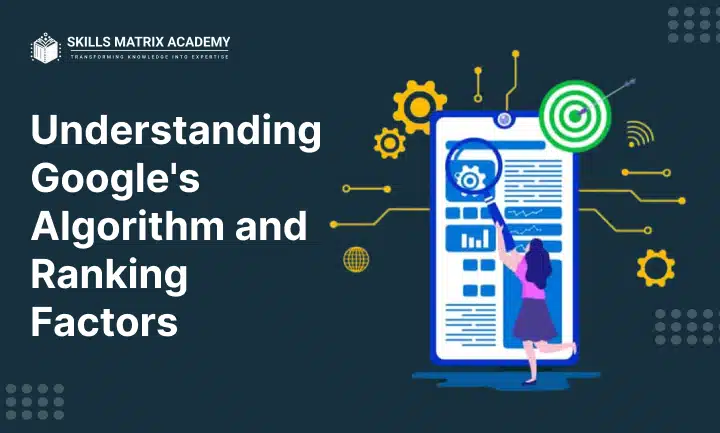Google algorithms power the world’s most popular search engine, deciding how web pages rank in search results. These evolving algorithms are complex and constantly changing, making them vital for digital marketing, SEO, and website development. They rely on ranking factors like content quality, keywords, site speed, backlinks, and user experience.
Google updates often change how pages perform, affecting search engine ranking. Staying updated with algorithm changes is essential. Using the right SEO tools and strategies helps maintain visibility. For example, a business offering a digital marketing course in Jaipur that improves mobile performance after an update can keep strong rankings.
Understanding Google’s Algorithm and Ranking Factors

Google’s algorithm is a set of rules and processes that decides how web pages appear in search engine results pages (SERPs). These algorithms assess many signals to measure the relevance, quality, and authority of a site. Their goal is to deliver the most valuable and accurate results for every query.
These ranking factors are critical for website SEO and play a key role in digital marketing success. While Google does not reveal the exact details of its ranking algorithm, experts have identified core factors that influence search rankings. Understanding these can help improve visibility and performance.
How Google’s Algorithm Works
Google’s algorithm uses three main processes: crawling, indexing, and ranking. Crawling discovers updated or new web pages. Indexing organizes the content so Google can retrieve it efficiently. Ranking sorts pages based on their relevance to a query. These processes happen continuously to keep SERPs fresh and accurate.
Key Ranking Factors
Here are the major ranking factors that impact your position in search results:
1. Page Speed
A fast-loading website improves user experience. Google rewards quick-loading sites with better rankings. Slow sites lead to higher bounce rates and lower visibility.
2. Content Relevance
Content must align with the keywords you target. Avoid keyword stuffing and focus on delivering valuable content. For example, a detailed guide in a digital marketing course in Jaipur will rank better if it answers user queries effectively.
3. Website Design
A clean, intuitive website design improves navigation and encourages visitors to stay longer. This enhances user experience and positively impacts rankings.
4. Link Quality
Links from authoritative sources increase your site’s credibility. Always ensure links are relevant and point to high-quality content. Low-quality links can harm your SEO.
5. Mobile-Friendliness
Google primarily uses the mobile version of a website for indexing and ranking. Sites that aren’t mobile-friendly risk losing rankings. Mobile optimization is essential for strong SEO performance.
6. HTTPS Status
Secure websites (HTTPS) gain user trust. Google favors HTTPS over HTTP as a ranking signal. Security impacts both website SEO and user confidence.
7. User Engagement
High bounce rates and low return visits suggest poor quality. Google uses engagement data to assess the value of your web pages. Sites that engage users consistently rank higher.
Key Google Algorithms and Updates

Google has developed several algorithms and updates to improve search results. These updates directly affect search rankings and SERPs. Each one focuses on specific ranking factors to give users better results. Knowing these updates is essential for digital marketing and good website SEO.
1. PageRank
PageRank is the first Google algorithm. Created by Larry Page and Sergey Brin in the late 1990s, it measures the importance of web pages. It looks at the number and link quality of backlinks. Pages with strong backlinks get higher authority and rank better in search rankings. PageRank still influences SEO today.
2. Panda Algorithm
Launched in 2011, the Panda algorithm focuses on content quality. It lowers the rank of sites with low-quality content and rewards high-quality ones. Panda checks content originality, relevance, and the number of ads. Sites with thin content or duplicated content are penalized. This update ensures better content appears higher in SERPs.
3. Penguin Algorithm
Introduced in 2012, the Penguin algorithm targets poor link practices. It focuses on link quality over quantity. Penguin penalizes sites with spammy or unnatural backlinks and rewards those with natural and varied links. This made ethical link building essential for improving search rankings.
4. Hummingbird Algorithm
Released in 2013, the Hummingbird algorithm improves how Google understands search intent. It uses semantic search and natural language processing to understand queries better. Hummingbird helps Google answer long-tail queries and conversational searches more accurately. This update made search results more relevant.
5. Pigeon Update
The Pigeon update of 2014 improved local search results. It refined how Google treats location-based queries, giving more relevance to local listings. This helps users find nearby businesses, products, or services. Local businesses benefit from better visibility thanks to Pigeon.
6. Mobile-Friendly Update (Mobilegeddon)
The Mobile-Friendly update, also called Mobilegeddon (2015), prioritizes mobile responsiveness. Google rewards sites that work well on mobile. As mobile browsing grew, this became a key ranking factor. Websites that aren’t mobile-friendly risk losing visibility. Mobile optimization is now essential for strong website SEO and a better user experience.
7. RankBrain
Introduced in 2015, RankBrain is an artificial intelligence part of Google’s ranking system. It uses machine learning to understand search queries better. RankBrain interprets unique or ambiguous searches and improves over time based on user behavior. This helps Google deliver more accurate search rankings.
8. Possum Update
The Possum update (2016) refined local search results. It removed duplicate listings and improved location accuracy. Possum helps nearby businesses appear more often in SERPs. This gave more opportunities to local businesses to stand out.
9. Fred Update
Launched in 2017, the Fred update focuses on sites that violate Google’s webmaster guidelines. It targets sites with low-quality, overly monetized content. Fred penalizes such sites and rewards those with a strong user experience. This encourages sites to improve content for users rather than focusing only on ads.
10. BERT Algorithm
Introduced in 2019, the BERT algorithm uses deep learning to improve natural language processing. It helps Google understand the meaning of words in a query. BERT improves results for complex and conversational searches, making search results more relevant and precise.
How These Algorithms Impact SEO

Understanding Google algorithms is essential for strong SEO strategies. These algorithms directly affect how websites rank in search results. They impact many parts of website SEO, from content quality to technical optimization.
Here’s how these updates affect SEO.
1. Content Quality
Updates like the Panda algorithm and Fred update focus on high-quality content. Google rewards sites that publish original content that matches user intent.
Avoid thin content or duplicated content, as they can lower rankings. Good content keeps your site trusted, relevant, and visible in search rankings.
2. Backlink Profile
The Penguin algorithm stresses the importance of a strong backlink profile. Google prefers natural backlinks from trusted sources.
Avoid manipulative link-building practices. Focus on earning links from reputable sources to boost your site’s authority and SEO performance.
3. Mobile Optimization
The Mobile-Friendly update (Mobilegeddon) made mobile optimization essential. Google gives preference to mobile-responsive design in rankings.
A mobile-friendly site improves user experience and keeps visitors engaged. Mobile optimization is now essential for successful website SEO.
4. Local SEO
The Pigeon update and Possum update strengthened local SEO. Google now gives more weight to location-based queries.
Optimize your Google My Business profile. Keep NAP consistency (Name, Address, Phone number) and collect positive reviews. This improves local search visibility and helps attract more local customers.
5. User Experience
The RankBrain and BERT algorithms focus on user experience and query relevance. They help Google deliver the best results for user queries.
Improve page load speed, make your site easy to navigate, and give users explicit, helpful content. Good user experience improves search rankings and keeps visitors coming back.
Why These Impacts Matter for SEO

Understanding these impacts is key to effective digital marketing. They decide how your site performs in SERPs. Ignoring them can harm visibility, even if your content is good.
A strong website SEO strategy includes good content, quality backlinks, mobile optimization, local SEO, and a smooth user experience. These keep your site aligned with Google’s updates.
Example: Applying Algorithm Knowledge
For example, a site offering a digital marketing course in Jaipur must adapt to these updates. This means:
- Creating original, helpful content that meets user intent.
- Building a strong backlink profile with links from relevant sources.
- Ensuring the website is mobile responsive.
- Keeping NAP consistency in Google My Business.
- Improving user experience with fast load times and straightforward navigation.
Following these steps improves search rankings, brings more visitors, and strengthens online presence.
How to Stay Ahead of Google Algorithm Updates

Google constantly updates its algorithms to deliver better and more relevant search results. Staying ahead of these changes is key to effective digital marketing and strong website SEO.
Here are proven strategies to help you adapt and maintain high search rankings.
1. Optimize for Mobile
A mobile-friendly website is essential. More people now use mobile devices for browsing. Google favors mobile-optimized sites in Google algorithm updates.
Ensure your website loads well and displays correctly on smartphones and tablets. A mobile-friendly design improves user experience and increases rankings.
2. Audit Your Inbound Links
Regularly review your inbound links to ensure they work and point to relevant, up-to-date content.
Check for broken links and outdated references. A healthy backlink profile is key to strong SEO strategies and maintaining visibility in search results.
3. Boost User Engagement
Create quality content that answers user search intent. This helps keep visitors interested and lowers bounce rates.
Use engaging visuals, clear headings, and concise content to keep users on your site longer. Better engagement improves your position in SERPs.
4. Decrease Site Load Time
Site speed affects both user experience and rankings. Use Google PageSpeed Insights to check page loading times.
Implement recommended improvements such as optimizing images, leveraging browser caching, and reducing unnecessary scripts. Faster websites improve rankings and provide a smoother, more satisfying user experience.
5. Avoid Duplicate Content
Duplicate content can harm your rankings. Use tools such as Siteliner to detect and eliminate duplicate content.
Ensure every page has unique information and value. This helps Google reward your site in algorithm updates.
6. Create Informative Content
Focus on informative content that provides value to the user and matches their intent.
Content that solves problems or answers questions keeps visitors engaged. This improves search rankings and strengthens your site’s authority.
7. Avoid Keyword Stuffing
Use keywords naturally. Overuse can lead to penalties in Google’s algorithm updates.
Write for humans first. Incorporate keywords naturally within headings, meta descriptions, and body content. This balances SEO and readability.
8. Don’t Over-Optimize
Avoid aggressive link-building practices or black hat tactics. Over-optimization can harm your rankings.
Maintain a balance in SEO. Focus on sustainable strategies that align with Google’s guidelines.
9. Improve Site Navigation
Straightforward site navigation helps both users and search engines.
Streamline menus and create a clear site map. This improves usability, lowers bounce rates, and helps Google index your site better.
10. Increase Page Security
Switch from HTTP to HTTPS. Secure websites rank higher and build trust with users.
Google rewards secure sites with better visibility. SSL certificates are now essential for all websites.
11. Update and Refresh Old Content
Regularly refresh your content to keep it relevant. Updated content signals Google that your site is active.
Review old posts and add new information, especially if ranking drops. This boosts both website SEO and user trust.
12. Monitor Your Website Metrics
Track performance using analytics tools. Watch for significant changes that might point to an algorithm update detection.
Monitoring metrics helps you respond quickly to changes and maintain your search presence.
13. Use External Google Algorithm Update Trackers
Tools like MozCast and Semrush Sensor provide alerts about significant changes in Google’s algorithms.
These tools help you stay informed and adapt your SEO strategies before your competitors.
Conclusion
Google algorithms may be complex, but mastering their fundamentals isn’t hard. Focus on high-quality content, a natural backlink profile, mobile optimization, local SEO, and great user experience.
Keep your SEO efforts aligned with Google’s ranking criteria, and you’ll see lasting SEO improvement.
Stay informed. Stay adaptable. Keep your website optimized and your content valuable. That’s the secret to long-term digital marketing success and sustainable SEO growth.
When your users win, your Google SEO wins too.









